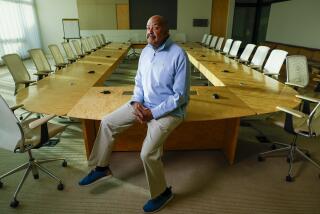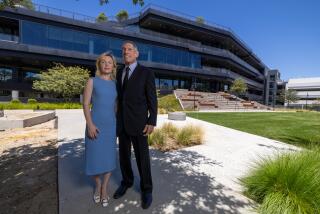Keck Gift Helps Start New Biotech Institute
- Share via
It has footed the bill to build the world’s largest telescope, funded science laboratories throughout California and chipped in to redesign a Santa Monica hospital crippled by earthquake damage.
Now the W.M. Keck Foundation has been identified as the source of a $50-million gift that seeks to change the face of American higher education. The second-largest grant ever by the Los Angeles-based philanthropy will found the first graduate school in the nation explicitly dedicated to preparing students for careers that embrace both engineering and the life sciences.
At a ceremony Thursday it also was revealed that the school to be built in Claremont, 35 miles east of Los Angeles, will be called the Keck Graduate Institute of Applied Life Sciences. The culmination of years of planning, its goal is to partner with industry to train a uniquely qualified work force that can translate research and scientific discovery into new products and services.
“This will be a merger of three kinds of distinctive American genius: that of engineering, that of scientific invention and that of entrepreneurism,” Gov. Pete Wilson said at the ceremony. “This new, small and very, very important institution is going to have an impact not just upon higher learning, not just upon sales, but upon our quality of life.”
The school--the first new member of the Claremont Colleges consortium in 30 years--hopes to enroll its first students in mid-1999. But Henry Riggs, president of the new institute, stressed Thursday that the Keck Foundation’s gift provides just half the money necessary to hire a core faculty of 15, build an 11-acre campus and actually open the doors.
Riggs, who formerly headed Harvey Mudd College, the engineering college that will be the new school’s neighbor, said he hoped that the founding grant would “ignite the interest of others in joining with us in this exciting adventure.”
The Keck Foundation is only the latest prominent benefactor to encourage interdisciplinary approaches to higher education in the sciences. Last month, the F.W. Olin Foundation donated $200 million to build an engineering college in Massachusetts that will seek to meld scientific subjects and real-life concerns such as product design and marketing.
*
The new school at Claremont is being billed as one-of-a-kind. While other graduate programs tend to train students to do scientific research, this one will emphasize practical skills, combining engineering training with courses in biology and chemistry. While most graduate schools churn out Ph.D.s, about 75% of the institute’s 125 students will pursue master’s degrees. The idea, Riggs said, is to give students a full understanding of what is required to function in industry--and then set them loose.
“The formation of this institute is in part a response to the cry that the nation’s universities are producing too many Ph.D. scientists these days, and that the training they receive is not well-tuned to the needs of industry,” said Riggs, adding that the school will seek to turn students who have undergraduate training in engineering or the sciences into “a new generation of bioengineers with leading-edge knowledge and a practical orientation.”
Already, the school has won praise from scholars, policymakers and business leaders.
*
President Clinton sent a congratulatory letter. Edward C. Stone, director of the Jet Propulsion Laboratory in Pasadena, took a break from supervising the Mars Pathfinder mission to help celebrate what he called a “bold step” that “brings together engineering and the biological sciences in a way that promises to revolutionize graduate education.”
Robert Tranquada, dean emeritus of USC’s School of Medicine and a member of the new institute’s founding board, agreed.
“Usually you get the one discipline--the biology or the engineering--but not [a program] oriented to the true interdisciplinary connections between them,” he said. “It sounds like a subtle difference, but it isn’t. It’s very profound.”
The new school’s eagerness to cooperate with industry has prompted some criticisms from those who fear that the school’s research mission soon would be defined by what is profitable, not what is important.
*
But Riggs said he is confident that academic freedom can be preserved. Moreover, he said he believes business people--some of whom will probably be adjunct professors--have a few things to teach academics.
“Sometimes we in higher education are a bit self-centered in thinking that most good new ideas occur at universities,” Riggs said. “A great deal goes on in industry from which we can learn. The partnership will go both ways.”
There is also hope that the proximity of Claremont’s other schools, including five undergraduate colleges--Claremont McKenna, Harvey Mudd, Pitzer, Pomona and Scripps--and Claremont Graduate University, will provide a humanizing influence on the new venture. Riggs has said he plans to make ethical issues central to the curriculum.
“The biomedicine and biotechnology area is replete with really interesting and challenging ethical questions,” he said. “This institution ought to engage those questions. Somebody needs to.”
“I don’t think there’s any better place to do this than Claremont,” said Robert Day, chairman and CEO of the Keck Foundation and grandson of the late W.M. Keck, founder of Superior Oil Co. Day praised Riggs particularly for being the “sparkplug” that has energized the project.
The Keck Foundation, one of the nation’s largest, has made grants of $550 million during its 43-year history. It focuses primarily on higher education, medical research, science and engineering. Its largest gifts--three grants totaling $135 million--went to build the huge 10-meter Keck Telescopes on Mauna Kea, Hawaii.
More to Read
Sign up for Essential California
The most important California stories and recommendations in your inbox every morning.
You may occasionally receive promotional content from the Los Angeles Times.













